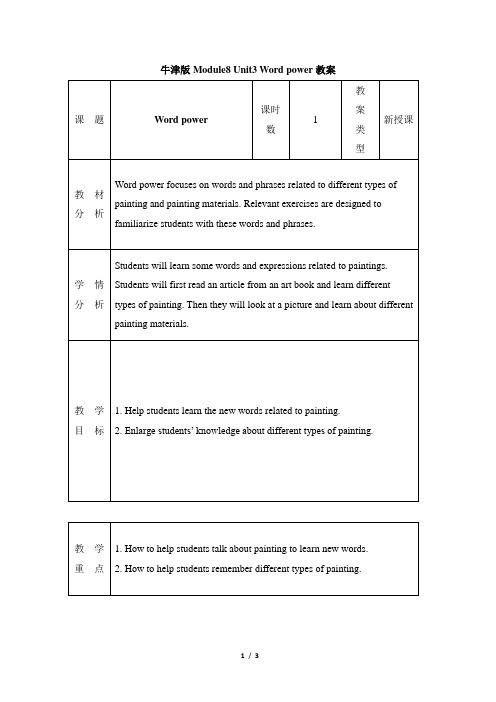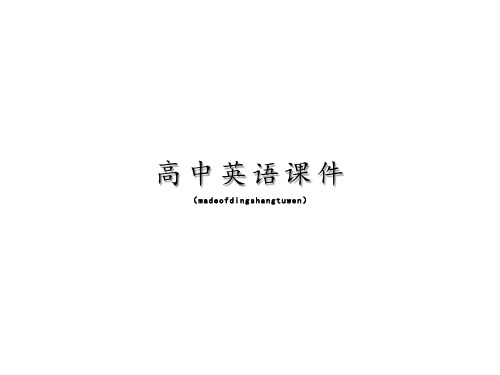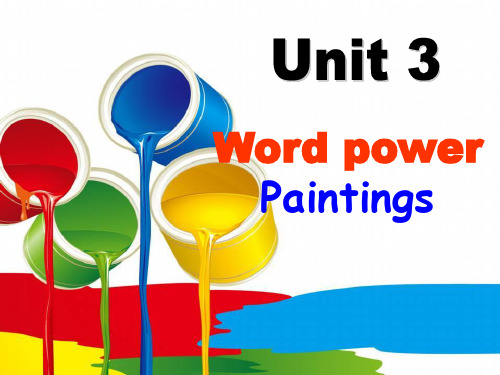U8U3Wordpowerpaintings教案-牛津译林版高二英语
- 格式:doc
- 大小:44.50 KB
- 文档页数:4





Period 3Word PowerTeaching goals:1) To e nlarge the students’ vocabulary about paintings2) To help them understand different types of paintings2) To practice and reinforce what they have learnt in this part.Teaching Important Points:1) Make the students be free to talk about the painting materials.2) Master the words in this part and use them freely.Teaching Methods:1) Talking to improve the students’ speaking ability.2) Practice to get the students to master what they have learnt.3) Discussion to make every student work in class.Teaching Aids:➢The multi media and the blackboardTeaching Procedures:Step1: Leading-inT: Since they have read a passage about some famous painters and their masterpieces, T can ask them to think the following questions to prepare forthe next step.)1)Do you know how an artist draws a painting?2)What painting materials and tools do they use?3)How many types of paintings do you know?(Ask the students to think about the questions with the text books closed.When they answer the third question, remind them that paintings can be put different groups according to different standards. While checking the answers, collect some key words on Bb which can help the students understand the passage in part A.)Step2.Vocabulary learningT: Tell them that they will read an article about different types of paintings peoplehave developed. Then collect their answers as follows.According to materials:WatercolourOil paintingAcrylic paintCharcoal drawingAccording to contents:PortraitLandscapeStill life(Make sure they what to do. While checking the answers, T can ask the students use the sentences in the article to describe each type of paintings according the materials. T can show them some paintings of different types. This can give them a clear and vivid impression. Meanwhile, let them pay attention to the words in blue. They can refer to the notes or their dictionary.)T: Then ask them to go on with Part B. This time they will learn more words related to various painting materials. Then let them look at the screen to tell the names of different painting materials with the books closed.Step3: PracticeT: Ask the students to complete Part C using the words they have learnt in Part A and B. Remind them to read the passage first and then fill in the blanks with proper words.Suggested Answers:1. watercolour2. oil3. pencils4. paper5. palette6. easel7.palette8. still lifeStep4: Vocabulary extensionT: Tell the students that this part will show some words used to describe colours.T can let them to tell some words about colours such as white, black, yellow, blue and so on. Then tell them many colours have different shades, like light blue and dark blue. Often they are similar to the colours of objects. So we canuse these objects to describe colours of different shades. Let them look at the words and get their exact meanings. Later match these words with correct pictures.Suggested Answers:1. rose2. cherry3. lemon4. olive green5. sea green6. lavender7. chocolate8. limeStep5: Language Pionts1.mix … with …将…同…混合mixture n. 混合物[C]2.build up 增加;搭建;build up one’s body 增强体质3.afford vt. (经济上、时间上)承担,负担得起afford to do sth 承担的起做某事e.g. I can’t afford a car.e.g. I can’t afford to buy a car.(Let them to do the relevant exercises in the WB to consolidate what they have learnt in this lesson.)Step6: Homework1.Get familiar with the words learnt in this lesson.2.Read some books about colours and drawing or ask your art teacher3.Preview the next period。

8Unit2 Word Power教案Period Three Word powerTeaching Aims:1.Learn to read a passage of something about an orchestra and instruments used in anorchestra.2.Enlarge the students’ vocabulary.Teaching Important Points:1.Understand the meanings of words and expressions related to an orchestra.2.Master the words in this part and use them freely.Teaching Difficult Points:1.Knowing the main idea of the passage.2.Remember some new words about an orchestra.Teaching procedures:Step 1 Greetings1.Greet the whole class as usual.2.Check their homework if any.Step 2 Brainstorming1.What is an orchestra like?2.What kind of music is performed by an orchestra? (classical music/opera)3.Do you know any famous orchestras in China or in other countries around theworld?Step 3 Vocabulary learning1.Read the web page in Part A carefully, and then complete the following chartwritten on the blackboard.Complete Part B individually and then check answers with a partner to see if they have got the answers.Suggested answers:strings: harp, violas, double bassesbrass: saxophones, trombones, tubaswoodwind: oboes, bassoons, piccolospercussion: timpani, xylophones, gongs2.Read the report and complete Part C individually referring to Parts A and B. Suggested answers:(1) orchestra (2) chamber (3) symphony(4) strings (5) brass (6) violins(7) cellos (8) brass (9) trumpets(10) Flutes (11) woodwind (12) bass drumsStep 4 Vocabulary extensionPlease focus on Part D and complete it individually.Answers to D:the instruments in red: stringsthe instruments in blue: woodwindthe instruments in green: brassthe instruments in yellow: percussionStep 5 Homework。
牛津高中英语教学设计单元:Unit 3 The world of colours and light板块:Word powerThoughts on the design:Word power部分既是对前面活动和内容的拓展,又是加深学生的绘画知识,其目的是帮助学生掌握主要绘画工具以及颜料的词汇表达,为本单元后面更深入的学习奠定基础。
Teaching aims:1. Get to know different types of painting materials & different tools for doing pictures.2. Give examples of different pictures done with different painting materials.3. Learn and master the new words related to paintings. Enlarge the vocabulary in this section and apply them to practical use.Teaching procedures:Step1: GreetingsGreet the whole class as usual.Step2: Lead-in(PPT 4-5)Before class, ask the students to surf the internet or refer to some reference books to get some information about types of painting and painting materials.Ask the students to report their findings in class. You may ask the students to provide pictures or objects to show to the class if necessary.Rainbow SongRed and yellow and pink and green,Orange and purple and blue.I can sing a rainbow; sing a rainbow,Sing a rainbow song.Q: Do you know any other colors?Step 3: Part A (PPT 6-11)1. Read part A carefully and answer the following questions.●What are two main types of painting?●How can they be done?●Styles of painting?Step 4: Learning Part B (PPT 12-13)Teach the students some words about the paintings.Watercolor, oil painting, canvas, acrylic paint, portrait, landscape, still life, palette, easel, paint brushes, pencils, oil paintsAsk the students to read these words three times.What painting materials a painter may use?Look at the picture and know of some painting materials.Step 5: Part C (PPT 14)Li Ming has decided to take up painting as a hobby. He found some advice on the Internet about starting to paint. Some of the words did not print out properly. Use the words from Parts A and B to complete it.KEY: (1) watercolours (2) oils (3) paintbrushes (4) pencils(5) paper (6) oil paints (7) portrait (8) still lifeStep 6: Part D (PPT 15)Guess: The colors of the objects?Have students look at the words presented in Part D, helping them understand that some words are the names of the objects which are of the similar colors. Besides the words listed, give more examples like: navy blue, pea green, blood-red, inky black, snow white.Step 7: Discussion (PPT 16-17)Many colours have different shades, like light blue and dark blue. Often the names of these shades are the same as the objects that are of a similar colour.plum 杨李色pansy 紫罗兰色peachpuff 桃色papayawhip 番木色rosybrown 褐玫瑰红springgreen 春绿色Step 8: Language Focus (PPT 17-22)1. The paint is very thick. The secret to oil painting is to build up layer on layer on a canvas.1) 积聚;聚集Traffic is building up along the roads to the coast.One day your books will build up into a library.2) 增进;加强发展体育运动,增强人民体质。
模块5 Unit 3 Word power(译林牛津版高二英语必修五教案教学设计)Teaching objects:1. learn prefix and suffix and learn to guess meanings based on prefix and suffix2. learn organs of the bodyTeaching procedures:I Prefixes and suffixesStep1 Lead-inPlease use the proper form of the words below to answer questions!able agree lead appear novel regular respect1. You can’t find your pen. What happened to your pen?2. You want to get the book on the top shelf, but you are not tall enough. Do you think you will be able to reach the book?3. The two groups don’t agree with each other. They argued fiercely. So what is the problem between them called?4. Many people respect Mr. Li and think he is a good man. He helps people out and is a good citizen and friend. So can you find a word to describe him?5. Mr. Wang has published several books. He loves his job writing novels. So what is Mr. Wang’s occupation (职业)?6. You can’t find the order of the numbers in a g roup of members. So can you find a word to describe the order of the numbers?7. Some ads say that if you take their pills, you’ll be healthy, look younger, become smarter and sleep better. What can you say about these ads?Step2 Prefixes and suffixesSometimes you can guess what a word means by looking at its prefix or suffix. Look at the left-hand column of each table. Try to find some examples and work out the meanings.Prefix Example Meaninganti-dis-in-il-im-ir-pro-re-un-Suffix Example Meaning-able-ful-ist-less-ment-nessStep3 Practice1. Do you think we should protect nature? Complete what an environmentalist is saying below. Use the following words.disrespect hopeless illegal uncertain understandableI think cutting down trees should be made ________and tighter laws should be introduced. So many people are showing their _________ for nature; they don’t seem to care that they are destroying the environment. Sometimes I think we’re fighting a _________battle against people who just don’t listen. I know scientists have worked hard to achieve scientific breakthroughsbut it’s ___________whether they’ll ever succeed totally. Although it’s _______________ that they want to advance technology, I think some things are best left the way they are.2. More practice about prefixes and suffixesⅡ Organs and the bodyStep4 Learn organs and the body through the pictureStep5 PracticeComplete the following passage using the names of the organs above:Think of the body like a school. At the top of the school is the headmaster, known as the (1) _______. This is the organ that controls the rest of the organs, just like the headmaster controls the school. After this comes the (2) ________. It is like a teacher. This organ passes the blood around the body so it can run well. This is similar to the knowledge a teacher gives to students. Next is the (3) _______, which is the student. This organ is the only one that can re-grow itself. It helps to clean the blood. This is like knowledge students get from teachers. Students always grow with newly found knowledge. The (4) _________are the organs of the body that use the oxygen we breathe. Think of the oxygen as the life you lead at school. The (5) ____________ is very useful as it stores the food we eat until we can digest it properly. This is similar to the learning process. We store the information until we need to use it. So this organ is like a notebook. The (6) ___________are the organs that remove waste products from the blood and produce urine.Step6 Homework1. Try to remember as many words and expressions about prefixes and suffixes.2. Keep the names of the organs in mind.。
牛津高中英语教学设计单元:Unit 3 The meaning of colour板块:Word powerThoughts on the design:本课件是以听、说、读为主的词汇教学课。
按照学生的认知规律,从温故知新——探索新知识——使用新知识——巩固新知识进行教学;针对词汇教学的特点,设计竟猜等一系列的课堂活动,鼓励学生参与,形成师生互动,以便更好地掌握本节课与国花有关联的单词和与颜色有关联的短语。
Teaching aims:After learning the word power, Ss will be able to know some words related to national flowers and some expressions related to colour idioms.Teaching procedures:Step 1 Revision1. Competition.Guess different names of the countries according to the national flags given. (PPT 5-6)2. Ask Ss to discuss the question:What kind of things can represent a country? (PPT 7-10)National flags, national flowers, national emblem, national anthem[Explanation]本课的教学从复习入手,让学生了解一些国家的国旗。
通过看国旗猜国家名称的竞赛活动,充分调动学生的学习热情和兴趣,寓教于乐。
然后通过回答问题What kind of things can represent a country? 导入到National flowers。
Step 2 Read and understandAsk Ss to read the article about national flowers for different countries in Part A.1. Ask Ss to find out which flowers are mentioned in the article as national symbols for different countries and give a brief description of each. (PPT 11-12)2. Encourage Ss to fill in the table. (PPT13-15)[Explanation]通过阅读第38页的文本, 让学生找出文中所介绍的几种国花,并对它们进行描述。